

Corinne Duyvis. Othering. Othering 101: What Is “Othering”? By “othering”, we mean any action by which an individual or group becomes mentally classified in somebody’s mind as “not one of us”.
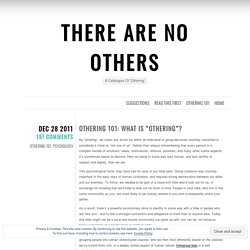
Rather than always remembering that every person is a complex bundle of emotions, ideas, motivations, reflexes, priorities, and many other subtle aspects, it’s sometimes easier to dismiss them as being in some way less human, and less worthy of respect and dignity, than we are. This psychological tactic may have had its uses in our tribal past. The Problem of Othering: Towards Inclusiveness and Belonging - Othering and Belonging. Introduction The problem of the twenty-first century is the problem of “othering.”

In a world beset by seemingly intractable and overwhelming challenges, virtually every global, national, and regional conflict is wrapped within or organized around one or more dimension of group-based difference. Othering undergirds territorial disputes, sectarian violence, military conflict, the spread of disease, hunger and food insecurity, and even climate change. In a remarkably candid and wide-ranging recently published interview, US president Barack Obama cited tribalism and atavism as a source of much conflict in the world. Privilege. National SEED Project - 'White Privilege: Unpacking the Invisible Knapsack' and 'Some Notes for Facilitators.
White Privilege: Unpacking the Invisible Knapsack Downloadable PDF © 1989 Peggy McIntosh "White Privilege: Unpacking the Invisible Knapsack" first appeared in Peace and Freedom Magazine, July/August, 1989, pp. 10-12, a publication of the Women’s International League for Peace and Freedom, Philadelphia, PA.
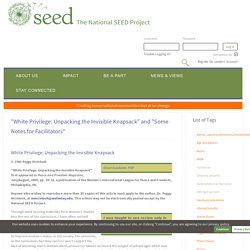
Anyone who wishes to reproduce more than 35 copies of this article must apply to the author, Dr. Intersectionality. Intersectionality 101. Diversity, Equity And Justice. Why Teach Multicultural Literature? Why teach multicultural literature in your English language arts classroom?
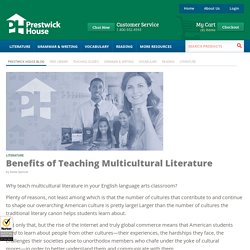
Plenty of reasons, not least among which is that the number of cultures that contribute to and continue to shape our overarching American culture is pretty large! Larger than the number of cultures the traditional literary canon helps students learn about. Not only that, but the rise of the internet and truly global commerce means that American students need to learn about people from other cultures—their experiences, the hardships they face, the challenges their societies pose to unorthodox members who chafe under the yoke of cultural mores—in order to better understand them and communicate with them.
Building Empathy If reading literary fiction can improve empathy, it stands to reason that reading multicultural literary fiction can help us better understand people from other cultures or marginalized people within our own. The Effects of Negative News on Young People: Harnessing Literacy for Healing. About Mirrors Windows Doors ~ What is Mirrors Windows Doors?

Mirrors Windows Doors (MWD) is an online magazine whose aim is to draw attention to the riches of children’s and YA books from across the world that highlight cultural and multi-cultural diversity. MWD promotes authenticity of voice, and writing that increases empathy through reading about different experiences within different cultural contexts – maybe next door, maybe across the globe – whilst tapping into a common bond of humanity and shared emotional response. Ezra Hyland on Education Talk Radio. Windows, Mirrors, and Sliding Doors. When the Black Caucus of NCTE established the African American Read-In (AARI) over 25 years ago, their ambitious yet confident premise was that a school and community reading event can be an effective way to promote diversity in children’s literature, encourage young people to read, and shine a spotlight on African American authors.
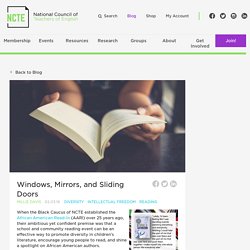
They knew what NCTE member Rudine Sims Bishop wisely wrote: Choosing Children's Books: Cultural Relevance Rubric. Just what makes a book culturally relevant?
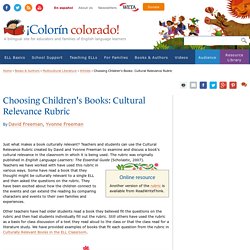
Teachers and students can use the Cultural Relevance Rubric created by David and Yvonne Freeman to examine and discuss a book's cultural relevance in the classroom in which it is being used. The rubric was originally published in English Language Learners: The Essential Guide (Scholastic, 2007). Online resource Another version of the rubric is available from ReadWriteThink. Teachers we have worked with have used this rubric in various ways. Literature Log - Multicultural Literature. 12-year-old Willow Chance is exceptional -- so gifted, the only place she feels she belongs is at home, with her adopted parents and her garden.

Definitely not at school, where she's been ordered to see a counselor, and where she has no friends. Then her parents are killed in a traffic accident, and Willow is left searching for a true place to belong. It turns out, she's not the only one. This book is a gorgeous story about identity, family, and grief. The language is careful and beautiful while still feeling authentic to the voice of a 12-year-old. We Need Diverse Books – weneeddiversebooks.org. Book Recommendations for the African American Read-In. This February, schools, churches, libraries, bookstores, and community and professional organizations throughout the country have been hosting African American Read-Ins to make literacy a significant part of Black History Month.

Choosing which books to share at a Read-In is one of the most challenging (and joyous) parts of hosting. There are so many fabulous books written by African American authors out there, how can you possibly choose? To help get you started, we asked our social media community to share some of their favorites. To see the original messages this list is based on, click here. Picture Books. There Is No Apolitical Classroom: Resources for Teaching in These Times.
The following post was created by members of NCTE’s Standing Committee Against Racism and Bias in the Teaching of English.
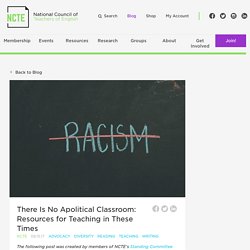
The members of NCTE’s Standing Committee Against Racism and Bias have felt an urgency since we each joined the committee to stand against racism and bias. Multicultural Children's Book Publisher. Rich in Color – Reading & Reviewing Diverse YA Books. Multicultural and Social Justice Books. I'm Here. I'm Queer. What the Hell do I read? Queering up your shelf, one rec at a time! In a Heartbeat - Animated Short Film. 8 Middle Grade Books with LGBTQ Characters. LGBT Perspectives in the Middle School Classroom. There has recently been a lot of buzz around a new short animated film entitled “In a Heartbeat.” I first saw it being shared on Facebook, and since it was posted on July 31st, it has been viewed over 20 million times. If you have not had the chance to view it yet, here is a link: In a Heartbeat.
Without giving too much away, this animated short film is the story of a young boy who has not yet come to terms with his sexuality, and ultimately leaves the viewer with the message, “the heart wants what the heart wants.” This short film is groundbreaking. It’s the first animated film I’ve ever seen from the point of view of an LGBT character, and it’s exactly what is needed in classrooms in order to spark a much-needed discussion with students in middle school.
LGBT youth are four times more likely to attempt suicide than their straight peers. Responding_to_Concerns_Teaching_About_Gender_030915.pdf. Bisexual – The Trevor Project. Gender Spectrum. Deadnaming. Graphix Teachers guide.
Drama by Raina Telgemeier - resources. The Prince and the Dressmaker by Jen Wang - resources. George by Alex Gino - resources. Dactyl Hill Squad by Daniel José Older. Julián is a Mermaid - Jessica Love. After a recent interview for Teaching for Change, I was encouraged to adapt a portion of the interview into a post on my own site. I'm including the two questions I get asked a lot, and their responses, below. 1. "Why did you choose to write Julián? What inspired the book? " I'm Your Neighbor Books: Immigration Children's Literature. Books to Help Kids Understand What It’s Like to Be a Refugee. We see the news stories about refugees almost every day. We hear the true but almost unimaginable accounts of families forced to flee their homes, their homelands, their entire lives. Teaching Refugees with Limited Formal Schooling. 8 educational resources to better understand the refugee crisis. The world refugee crisis has led civil society to mobilise, and initiatives calling for greater support to refugees have multiplied across countries.
The Refugee Experience for Middle Grade and YA Readers [in The Booklist Reader] This is the second in a two-part series of recommended books for youth about the refugee experience. For a list of picture books, click here. Best Kids Books About Refugees, as Chosen by Educators. A bilingual site for educators and families of English language learners. UNHCR - Teaching about refugees. With forced displacement reaching historic levels, schools all over the world are welcoming increasing numbers of refugee children. Teachers are facing new challenges in making sense of forced displacement and its complexities. Lubna and Pebble by Wendy Meddour and Daniel Egnéus.
Serafina's Promise by Ann E. Burg - resources. Stormy Seas by Mary Beth Leatherdale and Eleanor Shakespeare - resources. The Only Road by Alexandra Diaz - resources.